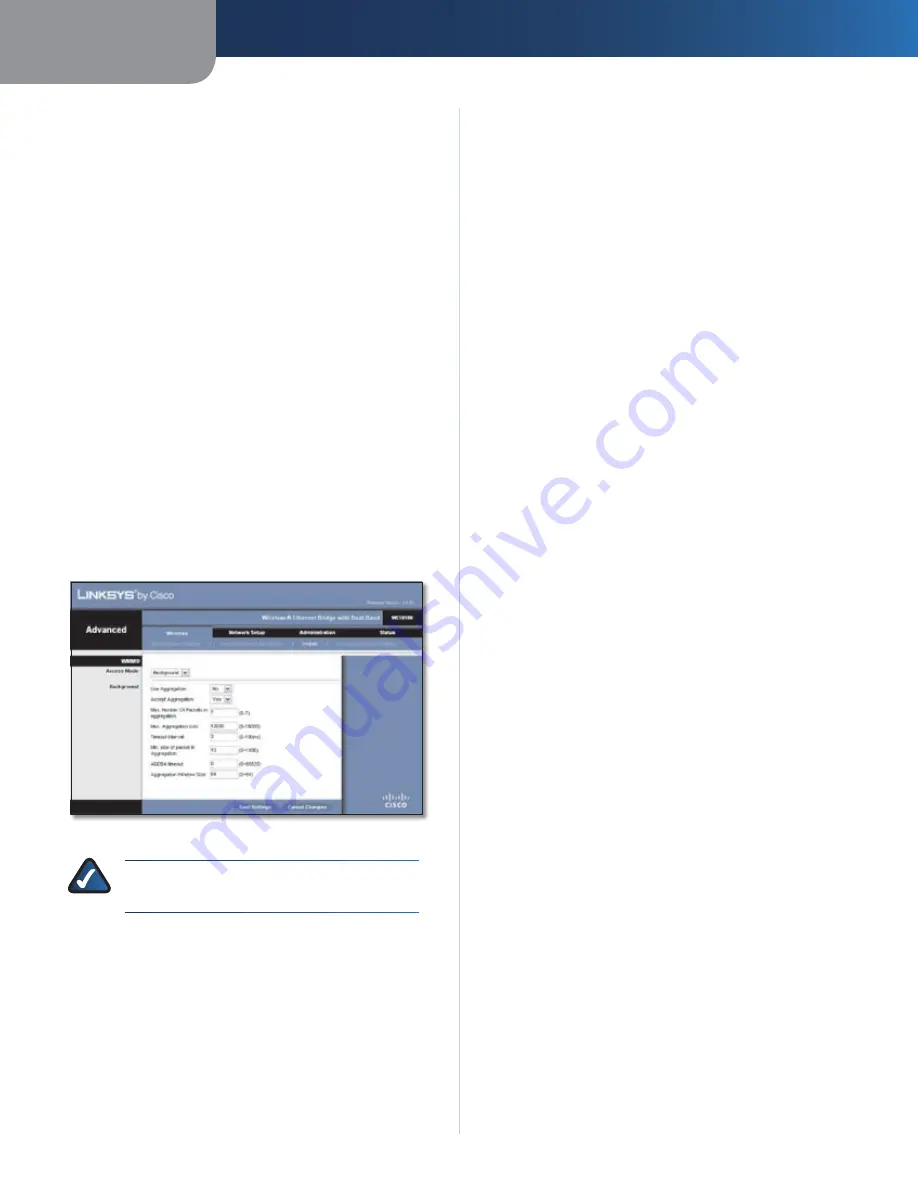
Chapter 3
Advanced Configuration
7
Wireless-N Ethernet Bridge with Dual-Band
Security Mode
WEP is automatically displayed.
Encryption
Select a level of WEP encryption,
40/64 bits
(10 hex digits)
or
104/128 bits (26 hex digits)
.
Key 1
Enter the WEP key of your network.
Tx Key
Key 1
is the transmit key used by the Bridge.
Authentication
The default is
Auto
, which allows either
Open system or Shared key authentication to be used.
Select
Open
to use open system authentication; the sender
and recipient do not use a WEP key for authentication.
Select
Shared
to use shared key authentication; the
sender and recipient use a WEP key for authentication.
Click
Refresh
to update the on-screen information.
After you have entered the security settings, click
Connect
.
Wireless > WMM®
Configure the Wireless MultiMedia (WMM) settings. WMM
prioritizes packets depending on their respective access
mode (traffic type): Background, Best Effort, Video, or
Voice. These settings should only be adjusted by an expert
administrator as incorrect settings can reduce wireless
performance.
Wireless > WMM
NOTE:
The settings on the
WMM
screen are
designed for advanced users only.
WMM
Access Mode
You can assign different settings to the four access
modes available. Select the mode you want to configure:
Background
,
Best Effort
,
Video
, or
Voice
. Follow the
instructions for the mode you select.
Background
Use Aggregation
This option defines whether or not the
Media Access Control (MAC) layer will set up an Add Block
Acknowledgement (ADDBA) session. The default is
No
.
Select
Yes
to enable this option.
Accept Aggregation
This option defines whether or not
the MAC layer will accept an ADDBA request. The default
is
Yes
. Select
No
to disable this option.
Max. Number of Packets in Aggregation
This option
defines the maximum number of packets (sub-frames) in
the aggregate. The range is
0
to
7
. The default is
7
.
Max. Aggregation Size
This option defines the maximum
size of the aggregate (in bytes). The range is
0
to
16000
.
The default is
12000
.
Timeout Internal
This option defines the timeout period
in which the aggregate should be closed with a “closing
condition” before it is closed by the timer. The range is
0
to
100
ms. The default is
3
.
Min. Size of Packet in Aggregation
This option defines
the minimum size (in bytes) of packets to be accumulated
in the aggregate. The range is
0
to
1500
. The default
is
10
.
ADDBA Timeout
This option defines the duration
after which the ADDBA setup is terminated, if there are
no frame exchanges within this duration by the Block
Acknowledgement (ACK) agreement. The range is
0
to
65535
ms. The default is
0
, which disables the timeout.
Aggregation Window Size
This option defines the
maximum number of packets transmitted without getting
ACKs. The range is
0
to
64
. The default is
64
.
Click
Save Settings
to apply your changes, or click
Cancel
Changes
to cancel your changes.
Best Effort
Use Aggregation
This option defines whether or not the
Media Access Control (MAC) layer will set up an Add Block
Acknowledgement (ADDBA) session. The default is
Yes
.
Select
No
to disable this option.
Accept Aggregation
This option defines whether or not
the MAC layer will accept an ADDBA request. The default
is
Yes
. Select
No
to disable this option.
Max. Number of Packets in Aggregation
This option
defines the maximum number of packets (sub-frames) in
the aggregate. The range is
0
to
10
. The default is
10
.
Max. Aggregation Size
This option defines the maximum
size of the aggregate (in bytes). The range is
0
to
20000
.
The default is
16000
.
Timeout Internal
This option defines the timeout period
in which the aggregate should be closed with a “closing

























